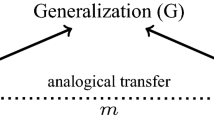Abstract
A formal model of analogy is introduced in the logic programming setting, and an analogical reasoning program (called DIANA, i.e. Declarative Inference by ANAlogy) is developed in accordance with precise procedural and declarative semantics. Given the source and target domains of analogy as two logic programsP s andP t , together with a specificationS of the analogical correspondence between predicate symbols, atoms involving these symbols are analogically derived fromP=P s ∪P t givenS, which are not derivable fromP s orP t orP s ∪P t alone. In this paper, the requirements of the analogical process are first stated. The declarative semantics of analogy is then given, by defining the least analogical model ofP as an extension of the classical semantics of Horn clauses. A procedural semantics is also described, in terms of an extension of SLD resolution. Both semantics rely on implicit analogical axioms defining the kind of analogical reasoning envisaged. The implementation of DIANA has been done in Reflective Prolog, a metalogic programming language previously developed by the first two authors. It is shown that analogical axioms can be viewed as an instance of reflection axioms used in Reflective Prolog. By exploiting this feature, the implementation of DIANA is argued to be sound w.r.t. the defined semantics. Examples of analogical reasoning in DIANA are also described. By comparison with the AI literature on analogy, it is claimed that this is the first approach which gives a declarative semantics to analogical reasoning, thanks to the possibility of carrying over in this field the basic logic programming concepts.
Similar content being viewed by others
References
S. Costantini and G.A. Lanzarone, A metalogic programming language,Proc. 6th Int. Conf. on Logic Programming, eds. G. Levi and M. Martelli (MIT Press, 1989) pp. 218–233.
S. Costantini and G.A. Lanzarone, Analogical reasoning in Reflective Prolog, in:Expert Systems in Law, ed. A. Martino (Elsevier, 1992) pp. 133–145.
S. Costantini and G.A. Lanzarone, A metalogic programming approach: Language, semantics and applications, J. Exp. Theor. Artificial Intelligence 6(1994)239–287.
S. Costantini and G.A. Lanzarone, Metalevel negation and non monotonic reasoning, J. Methods of Logic in Comp. Sci. 1(1994)111–140. (Abstract in:Proc. Workshop on Logic Programming and Non Monotonic Reasoning, Austin, TX (1990)).
T.R. Davies and S.J. Russel, A logical approach to reasoning by analogy,Proc. of IJCAI 87, ed. J. McDermott (Kaufmann, 1987) pp. 264–270.
R.P. Hall, Computational approaches to analogical reasoning: A comparative analysis, Artificial Intelligence 39(1989)39–120.
M. Haraguchi and S. Arikawa, Reasoning by analogy as a partial identity between models,Analogical and Inductive Inference, Proc. Int. Workshop on AII 1986, ed. K.P. Jantke, Lecture Notes in Comp. Sci. 265 (Springer, 1987) pp. 61–87.
N. Iwayama, K. Satoh and J. Arima, A formalization of generalization-based analogy in general logic programs,ECAI 92, Proc. 10th Euro. Conf. on Artificial Intelligence, ed. B. Nuemann (Wiley, 1992) pp. 129–133.
S. Kedar-Cabelli, Toward a computational model of purpose-directed analogy, in [14].
Y. Kodratoff, Using abductive recovery of failed proofs for problem solving by analogy,Proc. 7th Int. Conf. on Machine Learning (1990) pp. 295–303.
D. Leishman, An annotated bibliography of works on analogy, Int. J. Intelligent Syst. 5(1990)43–81.
J.W. Lloyd,Foundations of Logic Programming, 2nd Extended Ed. (Springer, 1987).
C.S. Peirce, Elements of logic, in:Collected Papers of Charles Sanders Peirce, Vol. 2, eds. C. Hartshorne and P. Weiss (Harvard University Press, 1932).
A. Prieditis,Analogica (Pitman, 1988).
B. Tausend and S. Bell, Analogical reasoning for logic programming,Machine Learning, Proc. Euro. Working Session on Learning 1991, ed. Y. Kodratoff, Lecture Notes in Artificial Intelligence 482 (Springer, 1991) pp. 391–397.
P. Winston, Learning and reasoning by analogy, Commun. ACM 23(1980)689–703.
P. Winston, Learning new principles from precedents and exercises, Artificial Intelligence 19(1982)321–350.
Author information
Authors and Affiliations
Rights and permissions
About this article
Cite this article
Costantini, S., Lanzarone, G.A. & Sbarbaro, L. A formal definition and a sound implementation of analogical reasoning in logic programming. Ann Math Artif Intell 14, 17–36 (1995). https://doi.org/10.1007/BF01530892
Issue Date:
DOI: https://doi.org/10.1007/BF01530892




